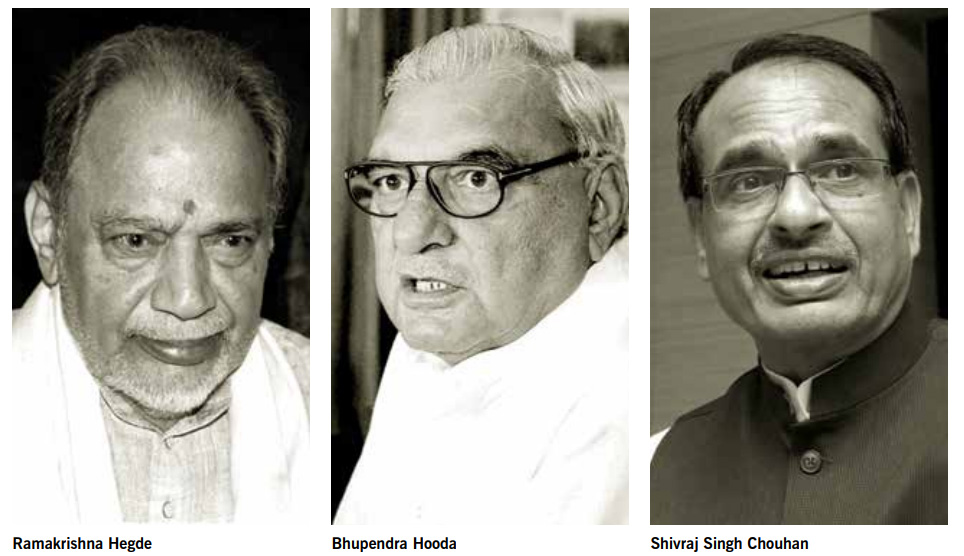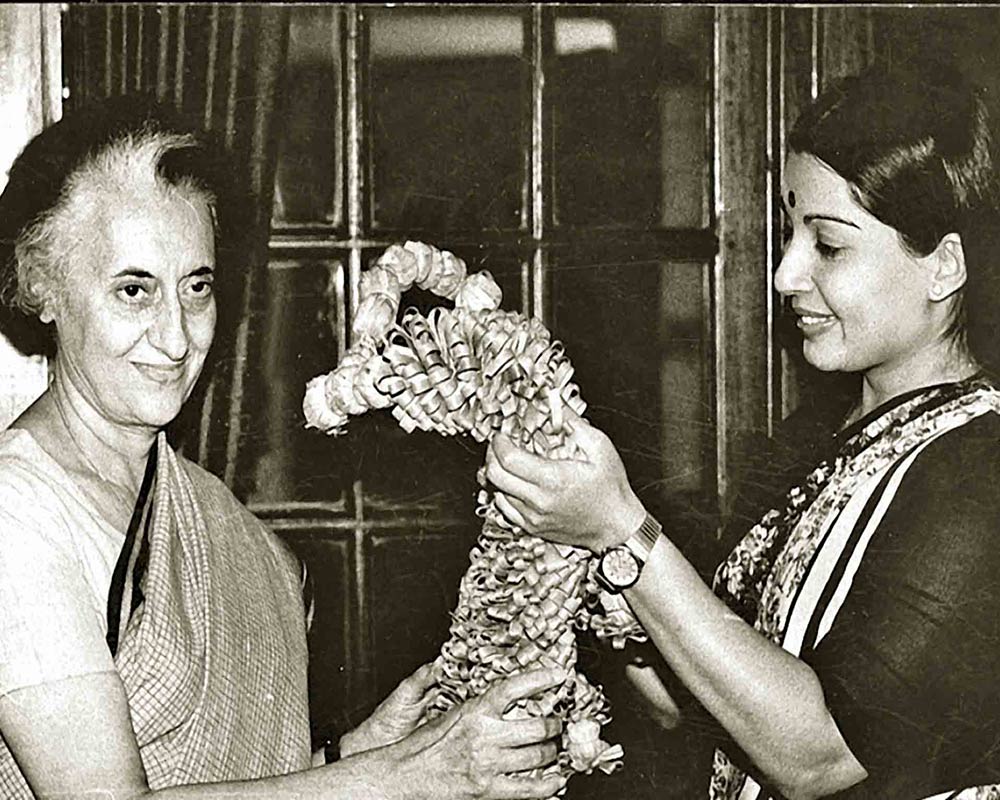AS we saw in the previous two pieces, Indira Gandhi dictated the new rules of corruption, which ensured that every single government deal, patronage, and official expenditure was controlled by the PM’s House or PM’s Office. She used the discretionary powers to benefit her loyalists and supporters. There was a cut or commission in everything. In advertently, she hastened a process that allowed chief ministers across the country to set up personalised, unique, and similar systems to hoard the illegal bounty.
Two issues, a verbal order and a precedent, helped the CMs to do what the PMs did. The first was the diktat from the centre that the CMs of the central ruling regimes had to contribute a fixed amount every year for the political party’s coffers. This obviously opened the doors for the state heads to earn Rs 1, if they had to send 50 paise to the central high command, and pocket the remaining amount. The second was that they aped what the PM did without fear, as illegality became the governance system.
So, when the PMs set up extra-constitutional authorities, either family members or kitchen cabinets, to monitor and control nationwide corruption, so did the CMs. When the PMs took away a part of the money spent, so did the CMs. When the national ruler systemised the dishonest acts, so did the CMs. When the PMs set up an elaborate mechanism to ensure that they were no or little leakage in the black economy, so did the CMs. In essence, the CMs mimicked what was happening at the centre.
In practice, although there were several similarities between the centre and the states, there were glaring differences too. At the ground level, the modus operandi was different among the various states. The acts and actions depended on the peculiarities in each state, in terms of expenditure and consumption, modes of manufacturing and services, and level of local revenues and central share of the annual budgets. The CMs were innovative enough to design and define novel ways to make money.
All in the family
Both at the central and states’ levels, the sons, daughters, sons-in-law, uncles, and husbands of the PMs and CMs became the controllers of the illegal wealth. They emerged as the real decision-takers without any moral responsibilities. Over the past several decades, there were damning examples in the states, as there were at the centre. The Badal family in Punjab, Chandan Basu, the son of the former CM, Jyoti Basu, in West Bengal, the loyalists of the late J Jayalalithaa in Tamil Nadu; the examples were galore.
Ironically, the first case related to such an extra-constitutional authority cropped up in the early 1960s, when the undivided Punjab was ruled by Pratap Singh Kairon. His critics submitted a memorandum to the President, which led to the formation of the SR Das Inquiry Commission. The memorandum said that people were “highly aggrieved by the misdeeds and blatant acts of corruption and gross misrule” by the chief minister, and the “partisan handling of the present Prime Minister Shri Jawaharlal Nehru”. Kairon’s critics were largely angry with the acts of his sons.
The Das Commission set a crucial precedent, which was unfortunately disregarded in the future. Like all the PMs, CMs, ministers, and politicians since Kairon pleaded, the Punjab chief minister maintained that the parents and in-laws of the non-political family members cannot be held responsible for the latter’s corruption. In effect, Kairon said that as a CM he cannot be held complicit for the acts of his son or son-in-law, who were not politicians, unless some form of a direct quid-pro-quo or bribe is involved.
Both at the central and states’ levels, the sons, daughters, sons-in-law, uncles, and husbands of the PMs and CMs became the controllers of the illegal wealth. They emerged as the real decision-takers without any moral responsibilities
Another argument, which was used frequently over the next few decades, was that “it would be unfair and unjust not to permit a person to do business simply because he happens to be the son or son-in-law of a person in authority”. Kairon told the Das Commission that if the “alleged misconduct and misdeeds of his sons had been brought to his notice… he would have warned them”. It was both a practical and morally-strong argument. It also appealed to the freedoms granted under the Constitution.
IN its report, the Das Commission listed several things that hinted, if not proved, the CM’s complicity. The first was that although the sons were free to carry on businesses, they couldn’t “exploit” the “influence” of their father, a chief minister. Such exploitation would deem the businesses illegal, even if the father “had not lent a helping hand”. Moreover, even as the allegations, whether they were true or not, “stared him in the face”, Kairon “paid no heed to them”. The CM should have given a “stern warning”, definitely in private and “if necessary publicly”, even the alleged conduct wasn’t proven.

Hence, the complicity of Kairon was established “by his remaining silent and not taking any steps to prevent it”. He didn’t opt for any inquiry, didn’t issue any warning, took no steps to stop the acts, and “let things drift in the way they had been going, assuming he had no hand in it”. Thus, the Das Commission concluded, “In view of his inaction in the fact of the circumstances hereinbefore alluded to, he must be held to have connived at the doings of his sons and relatives….” Kairon resigned.
OVER the next five decades, and until the present, CMs and their family members and loyalists continued to build near-monopoly businesses in several states, and amassed huge wealth. This was evident in the north (Himachal Pradesh, Haryana, and Punjab), west (Maharashtra and Gujarat), east (Odisha) and south (Tamil Nadu and Karnataka).
May be we can conclude with another example from the early 1960s, which was more dramatic. One of the allegations against Odisha’s CM Biju Patnaik was that he hived of the ailing Kalinga Industries, which he owned, to a state agency, even as he retained control over the company. He used the state machinery to expand the capacity of the company, and place an order with a German firm. As the CM got rid of the factory, he retained the lucrative mining lease, which was hugely profitable. In short, the losses were put in the state government’s pockets, and the large profits in his personal coffers.
CMs as colonisers
“Almost every CM, especially in states with ever-expanding cities, became a coloniser and a huge land owner, or a wealthy property owner,” says someone who worked closely with a chief minister as his media advisor. In sprawling and growing cities, urban land is at a premium, and any illegal and cheap allotment to builders or supporters is a source of ill-gotten money. Several chief ministers, like Ramakrishna Hegde and HD Dewe Gowda of Karnataka, were embroiled in such allotments in the mid-1980s.
Even agricultural land around a city can become a source of huge profits, if it is later designated as commercial or residential after acquisition by realtors. In newer cities like Gurgaon and Noida, this is a standard practice. Farm land is acquired by private builders, even politicians including the CM. Later, at the insistence of the CM, the land use is changed to commercial or residential. Suddenly, real estate prices shoot up by 100 times. When the plots or apartments are finally sold, the profits can zoom by 500 per cent.
There is another ruse to transfer the land to the builders, especially at the command of the chief ministers. Emergency powers are used by the city’s development authorities, like was the case with the Greater Noida Industrial Development Authority (GNIDA), to acquire huge tracts of land from the farmers for industrial use. This is done in “public interest” to promote growth and development. The compensation paid to the owners is either at or lower than the market rate, and decided by the authority.
In sprawling and growing cities, urban land is at a premium, and any illegal and cheap allotment to builders or supporters is a source of ill-gotten money. Several chief ministers, like Ramakrishna Hegde and HD Dewe Gowda of Karnataka, were embroiled in such allotments in the mid-1980s
Later, the usage of the acquired land is changed from industrial to residential and sold to the private builders, who make a killing by selling the built apartments at high prices to the consumers. In a seminal case in 2011, the Supreme Court ruled that such an acquisition by GNIDA “for undertaking an exercise of allotment of land to the builders” was “in complete violation of the purpose for which the land was sought to be acquired, even before the approval by the government for change of land use”.
In its order, the apex court sympathised with the farmers. “You (GNIDA) will not understand the psyche of the farmer. For him, land is a mother, his means of livelihood and sustenance. You are promoting the interest of the builder lobby in the guise of the public interest. In changing the land use from industrial to residential purpose, everything is meticulously planned. Your officers know it would be handed over to builders for a private purpose, but it doesn’t happen overnight. It is a brazen overreach of the judicial process.”

A former chief minister of Haryana, Bhupinder Hooda, went a step further in this art and science of purchasing land from the farmers at low prices, and handing it over to the realtors. He created fear and panic among the original owners. Between 2009 and 2012, the Hooda government decided to acquire over 1,400 acres in Gurgaon for its use. This triggered a panic sale by the farmers to private builders, as the former felt that they would get a better price from the realtors as compared to the government.
Later, the government purchased only a miniscule portion, about 6 per cent, of the proposed acquisition. It allowed the builders, who had bought the land, to use it for residential and other purposes. Hence, the realtors got the land at cheap prices, and sold it later at huge profits. This was managed, according to Central Bureau of Investigation (CBI), in connivance with the CM. The CBI maintained that the Hooda regime’s original purpose “to ensure availability of developed land at affordable prices to the public at large and to the economically-weaker sections of the society has not been achieved”.
This is why several states like Uttar Pradesh, Karnataka, Tamil Nadu, Punjab, and Haryana, the cities’ urban development authorities are hotbeds of corruption. They are the official colonisers in the respective states, and are in-charge of land acquisition and development. Most CMs influence their decisions, especially in the state capitals and other growing cities. Nothing moves without the chief ministers’ nods, and money exchanging pockets. Most chairmen of such authorities become millionaires.
DEVELOPMENT willy-nilly aids land corruption. Before a massive project, like a new airport, new highway, or economic zone, is announced by a state, its politicians, including CMs, buy huge tracts of land in the area. The original unsuspecting owners, unaware that the prices would go up in a short time after the announcement, sell at cheap prices. Thereafter, within a few weeks and months, the prices can go up 4-10 times. The beneficiaries are the CMs, along with their loyalists and supporters, which include the builders.
According to experts, the country’s property and land market is perhaps the largest contributor to the black economy, which comprises 20-50 per cent of the national GDP (gross domestic product). Barun Mitra, the founder and director of the Delhi-based Liberty Institute, has calculated that land transactions, including those related to natural resources like mining, generated $20 billion every year. This figure must have zoomed because this estimate was made about seven years ago.
Blunders in tenders
Wise chief ministers find various ways to rig the tendering process. They can even hand over projects to their friends without inviting any bids. Even when the process is open, it is manipulated in several ways. One of the main ways, especially in today’s era of online downloads of the tenders, the websites of the respective departments, where the tenders are available, either don’t open or fail to download the documents. Hence, the bidders need to visit the respective departments to procure hard copies.
Several states like Uttar Pradesh, Karnataka, Tamil Nadu, Punjab, and Haryana, the cities’ urban development authorities are hotbeds of corruption. They are the official colonisers in the respective states, and are in-charge of land acquisition and development. Most CMs influence their decisions, especially in the state capitals and other growing cities
However, the hard copies, in many cases, and especially for large projects, are given at the wishes of the respective CMs. Only three parties, whose names are pre-decided, manage to buy the documents. Others are told that they are unavailable. The choice of giving it to three bidders is to avoid future controversies; it gives the fig-leaf of an excuse that there was competitive bidding since three parties participated in the auction. Obviously, after the tender submission dates, the websites miraculously work perfectly.

Of the three parties, two of them are purposely rejected in the technical bids, without the knowledge of the bidders. Then the financial bids are opened. If the chosen party isn’t the highest or lowest bidder as the case may be, or L-1, it still bags the contract. The reason: the other two, even if they happen to be L-1 in the financial bids, are rejected at the technical stage. Hence, their bids become invalid, and the only one who had passed the technical stage becomes the L-1 in the financial bids by default. It is all stage-managed.
Although the central and state governments have now opted for e-tenders and e-auctions, the selection process remains the same, with unwanted parties rejected at the technical stage. In many cases, the bidders form a cartel, in collusion with the CMs and officials to eject out other parties. Then the contracts are rotated among the pre-selected parties so that the entire pie can be shared between themselves, and with their colluders.
Unofficial expenditure tax
In most states, there are some departments that are instant, and constant, money-churners for the CMs, and their loyalists. The most favourite are the public works departments (PWDs) in the cities, as well as rural areas. “The PWDS spend huge amounts on roads, buildings, construction, and other public works. There is an illegal commission on every rupee spent, a huge portion of which goes directly to the CMs,” explains an advisor to several chief ministers. Contractors usually pay 6-8 per cent of the project costs as bribes, a part of which is paid as advances and the rest when the payments are received.
Every individual has heard anecdotal stories, some of which are true, of how the state governments claim to have spent huge amounts on projects, which never see the light of the day. They remain on paper, and the entire sum is pocketed by corrupt politicians and officials, including the CMs. In larger cities like Delhi, Mumbai, Bangalore, and Kolkata, one is a mute witness to roads that are repaired just before the monsoons, and then re-repaired after the rainy season. The cycle goes on and on. It is a win-win situation for the contractors, who save costs by using inferior materials, and the CMs.

HEALTH is possibly the second most important minting machine. This includes the purchase of medicines and equipment by the government hospitals, which sell the former at subsidised rates or free to the people. Similarly, the states purchase books and other requirements for the government schools. The same is true in the case of public transport. All these purchases and, hence, the bribes are coordinated from the CMs’ offices. Although the money is shared along the hierarchy, the CMs are the chief recipients.
Depending on the states, the same is true for departments that deal with seeds, fertilisers, taxation like excise and other duties and, of course, power. Each state has its own specialised mafias, like mining and liquor, which pay obeisance to the CMs. Money is given in cash to the designated persons in the CMs’ residences of offices by the various mafias. It doesn’t matter which individual or political party is in power; the exchange happens seamlessly. Everyone is aware of how much needs to be paid.
The same is true for the grand welfare schemes, both central and state-driven, which dole out huge subsidies and freebies to the poor. In its 2017 verdict on Aadhaar, the Supreme Court quoted Rajiv Gandhi, the former and late prime minister, who said that only 15 paise of every rupee spent on the welfare schemes, reaches the poor, needy, and intended beneficiaries. Even today, the situation remains the same in several states, and the real beneficiaries of such colossal expenditure turn out to be the CMs.
WELFARE-ISM sometimes leads to hilarious and hugely unusual scams. Remember the Rs 950-crore fodder scam in Bihar, which the state’s former chief ministers, Jagannath Mishra and Laloo Prasad Yadav, were convicted. According to a website, “The fodder scam involved withdrawal of (state) money for supplying non-existent fodder for imaginary livestock…. It was found that in a large number of cases, fodder was not purchased or delivered, and fake bills produced.” The withdrawals continued for a decade.
Pay to get jobs
Since the states are the largest recruiters, especially in an era of jobless growth and high unemployment, the government jobs come at a price. There is an illegal tag on every teacher, policeman, and doctor, who are hired by the state departments, since these jobs are for life-time and come with huge benefits. The wily CMs go through the list of recruitments, which are normally cleared by their henchmen. So, if the price is Rs 100,000 for a teacher, 20-30 per cent goes to the CM, and the rest is shared at the lower levels.
Obviously, even admissions to professional courses run by the states are open to fraudulent practices because they ensure jobs in the near future. Consider the VYAPAM scam in Madhya Pradesh, which involved the former chief minister, Shivraj Singh Chouhan. According to a magazine, it was “one of the biggest cases of organised corruption in independent India”. It added, “Investigations threw up innumerable fraudulent admissions in state medical colleges and wrongful recruitment in various state government departments.”
Even admissions to professional courses run by the states are open to fraudulent practices because they ensure jobs in the near future. Consider the VYAPAM scam in Madhya Pradesh, which involved the former chief minister, Shivraj Singh Chouhan. According to a magazine, it was “one of the biggest cases of organised corruption in independent India”
VYAPAM, or the state’s Vyavasahik Pariksha Mandal (Professional Examination Board), held entrance examinations for the various courses in state-driven colleges. The exams were a scam and the seats were sold to candidates, who paid bribes. Investigators maintained that an MBBS seat cost between Rs 80 lakh and Rs 1.5 crore, depending on the college. The amount for a post-graduation seat was higher. Everyone with any power or influence was involved—CM, state and national politicians, bureaucrats, Governor’s Office, businessmen, rich professionals, and scores of middlemen.
Money was collected in a sophisticated manner, and accounted for, so that it could be shared at the various levels. As a magazine article explained, “Gradually, the process was institutionalised with the help of powerful beneficiaries of the system”, so much so that the entrance exams became a joke. Investigators found that there was a proper marketing team that “looked for interested candidates” and another systems team that “manipulated the roll numbers of candidates” to rig the exams.
Such systematic and systematised corruption was true for the other departments in various states, as was explained earlier. In fact, some of the CMs became so brazen and open that they didn’t even tried to hide the scandals from the public. Here, it may be apt to mention the case of a former chief minister of Uttar Pradesh, Chandra Bhanu Gupta. People openly said that his initials, CB, stood for Chor Bazaar (Thief’s Market). In one instance, an unabashed Gupta too called himself a thief.
Whether they acknowledged it or not, most CMs turned out to be the pirates of the worst kind. Their faces and names changed over the decades, but they systematically looted the nation, and deprived the citizens of their benefits. The CMs, in their various avatars, continued to roll the loaded dices of corruption, and became wealthy and powerful. Only a few got caught, and were convicted by the courts. Most enjoyed the comforts of their gains. Rest assured, the same will continue in the future. Also rest assured, we will continue to track the various CMs’ scams and scandals.




























































